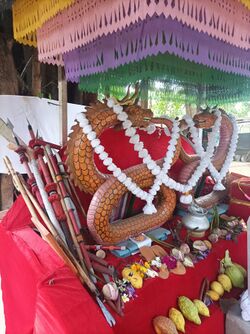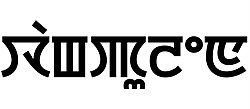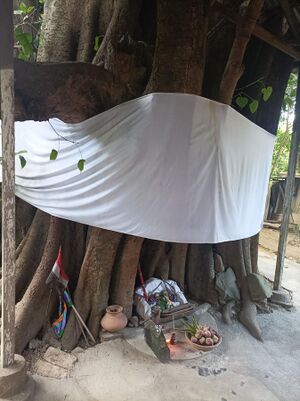Religion:Wangpulen
| Wangpulen | |
|---|---|
| Member of Lainingthous and Maikei Ngaakpa Lais | |
 Holy images of God Wangpulen and his divine consort, worshipped in the forms of Meitei dragons, in the sacred site of Lord Wangpulen (Wangbren), inside the Kangla Fort in Imphal | |
| Other names |
|
| Ancient Meitei |  |
| Affiliation | Meitei mythology (Manipuri mythology) and Meitei religion (Sanamahism) |
| Major cult center | Sugnu |
| Abode | underwater world |
| Weapon | Polo stick |
| Texts | Wakoklon Heelel Thilel Salai Amailon Pukok Puya |
| Gender | Male |
| Region | Ancient Kangleipak (Antique Manipur) |
| Ethnic group | Meitei ethnicity |
| Festivals | Lai Haraoba |
| Consort | Shangnu (alias Shangnulembi) |
| Offspring | Lok Ningthou |
| Greek equivalent | Poseidon, Oceanus |
Wangpulen (also, Wangpuren or Wangbaren or Wangbren) is the god of water, rain, flood, disease and sickness in Meitei mythology and religion of Ancient Kangleipak (Antique Manipur). He is the ruler of the underwater world.[1][2][4] He is the Lord of the rivers.[5] The guardianship of the south eastern direction is alluded to Wangbren and the other directions to Koupalu (north west), Marjing (north east) and Thangjing (south west).[5][6] He is one of the Umang Lais.[7][8]
He has a strong connection with the Anal tribe (Anan tribe) for marrying a lady of the Anal Khullen village.[9][10] Among the cult centres dedicated to him, the one at Sugnu is the most significant in Meitei pantheon.[5][11]
Description
In the Wakoklon Heelel Thilel Salai Amailon Pukok Puya, Wangbren is mentioned as "Khana Chaopa Wangpulen". According to the text, He is one of the 7 Laipungthous and one of the manifestations of the Supreme God, Ipung Loinapa Apakpa.[12]
Mythology

Once God Wangpulen went to the village of the Anal people, disguising Himself as a human. He fell in love with a beautiful girl, Shangnu. The maiden was also attracted to His good looks. The girl's affair with a stranger angered the community. The young men of the village challenged Wangbren to fight. There were competitions in race, stone throw, and archery. If He failed, He would be killed. But He won all the challenges. As He won, He took Shangnu, the maiden away with Him to His divine abode.[9][10][13][14]
Worship
Whenever one gets drowned, Wangpulen is worshipped according to the traditional rites and rituals. They did so in a belief that there will be no further deaths in water. Whenever unusual flood water currents are seen, especially in rivers, He is worshipped by people to save them from drowning and other mishaps.[15]
If a drowned person's dead body is not found, then a portion of the trunk of palash tree (Butea monosperma) is cremated. It is done in a belief that Wangpulen might have kept the corpse at a sacred place.[16]
Wangpulen is worshipped by offering fruits, flowers and kabok. The rites and rituals are performed by the maibas. It is to ward off the diseases, illness or sickness caused by the water god. Examples include skin diseases, cold and cough, diarrhoea, etc.[2]

In the planning,
- A denotes the spot of burial of gold models.
- B denotes the position of the cloth on which clothes of Lai (Male Deity) and Lairemma (Female Deity) were laid.
- C denotes the position of the rice pot.
- D denotes the position of the 3 dried plantain leaves containing rice, betel nut, plantains, sugarcane, flowers and fruits.
- E denotes the position of the plantain leaf on which cucumbers and other vegetables are offered to God Khana Chaoba Wangpulen.
- F denotes the position of the cloth on which a cloth is knotted to represent a man (a rag doll).
- G denotes the position of Moirang Keirungba.
- H denotes the position of Moirang Ningthou (lit. King of Moirang).
- I denotes the position of the King.
- J denotes the position of the Maiba.
- K denotes the position of Suganu Hanjaba.
- M and N denote the position of the attendants.
- O denotes the position of a fowl kept.
Cults and Shrines

A sacred shrine dedicated to Wangpulen still exists today in the Sugnu village. Annually, the non-Christian Anal villagers give offerings to their priest. The priest took and offer the articles to the God in Sugnu.[11]
Inside the Kangla, the State Government of Manipur is to renovate and reconstruct the holy altars dedicated to God Wangpulen and other deities.[17]
In 2010, a temple dedicated to God Wangpulen was constructed at Wangoi, Manipur. The temple building construction costs ₹8 lakh (equivalent to ₹14 lakh or US$20,000 in 2023).[18]
See also
- Koupalu - north west protector
- Marjing - north east protector
- Thangching - south west protector
References
- ↑ 1.0 1.1 Devi, Lairenlakpam Bino (2002) (in en). The Lois of Manipur: Andro, Khurkhul, Phayeng and Sekmai. Mittal Publications. ISBN 978-81-7099-849-5. https://books.google.com/books?id=tIBymmBWqgsC&q=wangbren+water+god&pg=PA50.
- ↑ 2.0 2.1 2.2 Chaudhury, Sukant Kumar (2006-01-01) (in en). Culture, Ecology, and Sustainable Development. Mittal Publications. ISBN 978-81-8324-132-8. https://books.google.com/books?id=zmxK-f7EA6kC&dq=worshipping+water+god+Wangbren+fruits+flowers+kabok+eatable+item+rice+ritual+process+performed+maiba+ward+-+off+illnesses+caused+water+god&pg=PA148.
- ↑ Roy, L. Somi (2021-06-21) (in en). And That Is Why... Manipuri Myths Retold. Penguin Random House India Private Limited. ISBN 978-93-91149-65-9. https://books.google.com/books?id=XxovEAAAQBAJ&q=Wangbrel%2C+Lord+of+Water&pg=PT102.
- ↑ Roy, L. Somi (2021-06-21) (in en). And That Is Why... Manipuri Myths Retold. Penguin Random House India Private Limited. ISBN 978-93-91149-65-9. https://books.google.com/books?id=XxovEAAAQBAJ&q=Wangbrel%2C+Lord+of+Water&pg=PT102.
- ↑ 5.0 5.1 5.2 Feminism in a traditional society : women of the Manipur Valley. pp. 116. https://archive.org/details/feminismintradit0000chak/page/116/mode/2up?q=Wangbren+sugnu+southeast+lord+rivers.
- ↑ Dzüvichü, Lipokmar; Baruah, Manjeet (2017-11-13) (in en). Modern Practices in North East India: History, Culture, Representation. Taylor & Francis. ISBN 978-1-351-27134-9. https://books.google.com/books?id=C2Q-DwAAQBAJ&q=guardianship+of+the+four+respective+directions+alluded+to+the+Gods+%E2%80%93+Wangbren+for+south%E2%80%93east&pg=PT355.
- ↑ Ghosh, G. K. (2008) (in en). Bamboo: The Wonderful Grass. APH Publishing. ISBN 978-81-313-0369-6. https://books.google.com/books?id=FH4Bb7dD4qYC&q=Wangbren+one+Umanglais+Meiteis&pg=PA132.
- ↑ Tree symbol worship in India; a new survey of a pattern of folk-religion. pp. 88. https://archive.org/details/treesymbolworshi0000seng/page/88/mode/2up?q=Wangbrel+umang+lais+protector+country+side.
- ↑ 9.0 9.1 "Wangbren-Shangnu legend testifies age-old hill-valley bond". http://e-pao.net/GP.asp?src=11..071117.nov17.
- ↑ 10.0 10.1 "WANGBREN-SHANGNU LEGEND TESTIFIES AGE-OLD HILL-VALLEY BOND". https://www.pothashang.in/2017/11/06/wangbren-shangnu-legend-testifies-age-old-hill-valley-bond/.
- ↑ 11.0 11.1 Miri, Sujata (2004) (in en). Rationality and Tribal Thought. Mittal Publications. ISBN 978-81-7099-912-6. https://books.google.com/books?id=z269EdNl83UC&q=Wangbren%27s+sacred+shrine+still+exists+today+Sugnu+village+every+year+non+-+Christian+Anals+every+village+give+clothes+%2C+vegetables+priest+who+takes+articles+Sugnu+offers+deity&pg=PA140.
- ↑ Singh, L. Bhagyachandra (1991). A Critical Study Of The Religious Philosophy. pp. 63. http://archive.org/details/in.ernet.dli.2015.461915/page/n63/mode/2up?q=Wangbren+wakoklon+hilel+thilel+salai+amailon+pukok+puya+khana+chaopa+wangpulon+seven+laipungthous+supreme+ipung+loinapa+apakpa.
- ↑ Folktales of Manipur. pp. 185. https://archive.org/details/dli.language.1358/page/n185/mode/2up?q=Wangbrel.
- ↑ Folktales of Manipur. pp. 187. https://archive.org/details/dli.language.1358/page/n187/mode/2up?q=Wangbrel.
- ↑ Raatan, T. (2004) (in en). Encyclopaedia of North-east India. ISBN 978-81-7835-274-9. https://books.google.com/books?id=-tv9WOAVh5AC&dq=Whenever+cases%C2%A0drowning%C2%A0take+place+valley+Manipur+large+numbers+people+worship%C2%A0Wangbren%C2%A0as+per+traditional+rites+belief+be+no+further+death+water+Whenever+abnormal+signs+seen%C2%A0currents+rivers+flood+season+proficiate+seek+blessings+save+accidents&pg=PA182.
- ↑ Sood, S. K.; Thakur, V.; Lakhanpal, T. N. (2005-04-01) (in en). Sacred and Magico-Religious Plants of India. Scientific Publishers. ISBN 978-93-87741-46-1. https://books.google.com/books?id=M85eDwAAQBAJ&q=If+the+dead+body+of+a+drowned+person+is+not+traceable%2C+a+portion+of+the+tree+trunk+of+%27Palash%27+is+then+cremated+with+a+belief+that+water+god+%27Wangbren%27+might+have+kept+the+dead+body+at+a+sacred+place.+&pg=PA31.
- ↑ Mehrotra, Deepti Priya (2009-07-08) (in en). Burning Bright Irom Sharmila. Penguin UK. ISBN 978-81-8475-153-6. https://books.google.com/books?id=w577ssi6CTAC&q=Kangla+Fort+state+government+proposes+to+renovate+and+reconstruct+the+coronation+hall+and+palaces%2C+the+mud+wall+fencing+all+around%2C+the+altars+to+Wangbren&pg=PT197.
- ↑ "Ibudhou Wangbran Khana Chaoba temple inaugurated". http://e-pao.net/GP.asp?src=25..221210.dec10.
External links
| Wikimedia Commons has media related to Wangpulen. |
